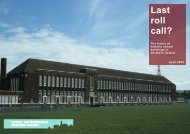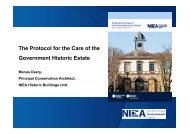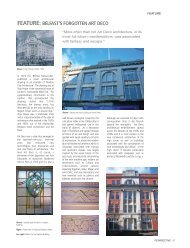Directory of Traditional Building Skills - Mourne Heritage Trust
Directory of Traditional Building Skills - Mourne Heritage Trust
Directory of Traditional Building Skills - Mourne Heritage Trust
Create successful ePaper yourself
Turn your PDF publications into a flip-book with our unique Google optimized e-Paper software.
5 JOINERYOf all building elements windows, doors, their fittings and embellishments can usually tellmore <strong>of</strong> the history <strong>of</strong> a building than any other. Unfortunately many Georgian terraces,Victorian houses and Edwardian villas have had their picture rails, deeply moulded skirtingsand architraves removed, but fashions change and many people now want to restore some <strong>of</strong>the character <strong>of</strong> their buildings.Wood is still the most versatile construction material known and for interior fittings isunsurpassed. Good joiners can make anything from a drawing, a scrap <strong>of</strong> the original or evena photograph. There are ranges <strong>of</strong> standard mouldings, in many cases these will be appropriate,but local and regional variation is important and particular mouldings may be specially cut. Itis usually not much more expensive to do this particularly when long runs are involved. Thescale and proportion <strong>of</strong> the room should determine the complexity <strong>of</strong> the mouldings otherwisethe joinery becomes grander than the building. For replication purposes examples may befound from other houses <strong>of</strong> the same period which have not been altered or from museums orphotographs. Sometimes details on the outside <strong>of</strong> the building were replicated inside. Oftenmouldings were covered up rather than torn out and may be found tucked away under the stairsor in the attic.Windows deserve a special mention as they are probably the most important factor in theappearance <strong>of</strong> a building. Timber sliding sash windows, the glazing <strong>of</strong>ten divided into smallrectangular panes, are the most common traditional window type in Ireland. They lookmarvellous and give efficient ventilation control and ease <strong>of</strong> escape in the case <strong>of</strong> a fire.However, they have a reputation for being draughty and hard to maintain. These problems areexaggerated by salesmen <strong>of</strong> PVC-U replacements who claim their reproductions look the sameand as a result, a rash <strong>of</strong> replacement windows is sweeping the country. Sometimes thin stripsare inserted between two panes <strong>of</strong> a double glazed unit in an attempt to replicate the pattern <strong>of</strong>glazing bars, but they fail miserably, fool nobody, are awkward and clumsy, an insult to an oldhouse and stomach turning pastiche in a new one. In addition, there is growing concern overthe environmental implications <strong>of</strong> the use <strong>of</strong> PVC-U and the toxic waste it can give <strong>of</strong>f in fires.It is always preferable, and <strong>of</strong>ten cheaper, to repair rather than to replace original windows;exact replacements <strong>of</strong> fine glazing bars and mouldings can be made. Details like the width <strong>of</strong>frame showing around the window on the outside are <strong>of</strong> historical importance and should befaithfully matched. <strong>Traditional</strong> sash windows can be fully draught pro<strong>of</strong>ed, easily andinexpensively, with a comprehensive system <strong>of</strong> brushes and seals. Fitting ‘Simplex’ sash hingesallow the windows to be cleaned from the inside. In the event <strong>of</strong> decay, hardwood sections,painted to match the original, can be inserted as in many cases it is only small areas <strong>of</strong> the sash,usually the cill member, that have decayed.Weights, sash cords and pulley wheels can be overhauled and replacements are also available.Some very small windows never had weights, instead a piece <strong>of</strong> wood jammed the sash open.Modern spiral balances are an appropriate replacement in some circumstances but in listedbuildings the original system should be replicated.Leaded windows have also been in use since very early times. In the late eighteenth centurysome <strong>of</strong> the simpler forms <strong>of</strong> leaded windows were copied in cast iron but these forms are rarein comparison to the vertically sliding sash windows.92











